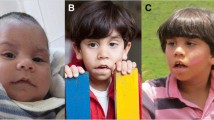Abstract
A male patient carrying an interstitial deletion in Xp22.3 and affected by Kallmann syndrome, X-linked ichthyosis and mental retardation, but without chondrodysplasia punctata or short stature, was investigated with molecular probes from the distal Xp22.3 region. By means of a novel probe, M115, from the relevant region, the distal deletion breakpoint was shown to be between 3.18 and 3.57 Mb from Xptel. As the patient is not affected by X-linked recessive chondrodysplasia punctata, the gene for this disease can therefore be located to within an interval of less than one megabase proximal to the pseudoautosomal boundary. If the chondrodysplasia punctata gene is associated with a CpG island, this leaves only two islands at 2760 and 3180 kb from the Xp telomere as the most promising candidate sites for this gene.
Similar content being viewed by others
References
Agematsu K, Koike K, Morosawa H, Nakahori Y, Nakagome Y, Akabane T (1988) Chondrodysplasia punctata with X;Y translocation. Hum Genet 80:105–107
Antequera F, Boyes J, Bird A (1990) High levels of de novo methylation and altered chromatin structure at CpG islands in cell lines. Cell 62:503–514
Armour JAL, Povey S, Jeremiah S, Jeffreys AJ (1990) Systematic cloning of human minisatellites from ordered array charomid libraries. Genomics 8:501–512
Ballabio A, Bardoni B, Carrozzo R, Andria G, Persico G, Bick D, Campbell L, Ropers HH, Ferguson-Smith MA, Gimelli G, Fraccaro M, Maraschio P, Zuffardi O, Guioli S, Camerino G (1989) Contiguous gene syndromes due to deletions in the distal short arm of the human X chromosomes. Proc Natl Acad Sci USA 86:10001–10005
Bick D, Curry CJR, McGill JR, Schorderet DF, Bux RC, Moore CM (1989) Male infant with ichthyosis. Kallmann syndrome, chondrodysplasia punctata, and an Xp chromosome deletion. Am J Med Genet 33:100–107
Cooke HJ, Brown WRA, Rappold GA (1985) Hypervariable telomeric sequences from the human sex chromosomes are pseudoautosomal. Nature 317:687–692
Curry CJR, Magenis RE, Brown M, Lanman JT Jr, Tsai J, O'Lague P, Goodfellow P, Mohandas T, Bergner EA, Shapiro LJ (1984) Inherited chondrodysplasia punctata due to a deletion of the terminal short arm of an X chromosome. N Engl J Med 311:1010–1015
Henke A, Rappold G (1993) PA2.1 detects a TaqI polymorphism in the pseudoautosomal region. Hum Mol Genet 2:339
Herrmann BG, Barlow DP, Lehrach H (1987) A large inverted duplication allows homologous recombination between chromosomes heterozygous for the proximal t-complex inversion. Cell 48:813–825
Klink A, Wapenaar M, Ommen GJB van, Rappold G (1993) AK1 detects a VNTR locus in the pseudoautosomal region. Hum Mol Genet 2:339
Koenig M, Camerino G, Heilig R, Mandel JL (1984) A DNA fragment from the human X chromosome which detects a partially homologous sequence on the Y chromosome long arm. Nucleic Acids Res 12:4079–4109
Maldergem L van, Espeel M, Roels F, Petit C, Dacremont G, Wanders RJA, Verloes A, Gillerot Y (1991) X-linked recessive chondrodysplasia punctata with XY translocation in a stillborn fetus. Hum Genet 87:661–664
McKusick V (1992) Mendelian inheritance in man. Catalog of autosomal dominant, autosomal recessive and X-linked phenotypes, 10th edn. Johns Hopkins University Press, Baltimore
Meindl A, Hosenfeld D, Brückl W, Schuffenhauer S, Jenderny J, Bacskulin A, Oppermann H, Bouloux P, Meitinger T (1993) Analysis of a terminal Xp22.3 deletion in a patient with six monogenic disorders: implications for the mapping of X-linked ocular albinism. J Med Genet 30:838–843
Mondello C, Ropers HH, Craig IW, Tolley E, Goodfellow PN (1987) Physical mapping of genes and sequences at the end of the human X chromosome short arm. Ann Hum Genet 51:137–143
Petit C, Melki J, Levilliers J, Serville F, Weissenbach J, Maroteaux P (1990a) An interstitial deletion in Xp22.3 in a family with X-linked recessive chondrodysplasia punctata and short stature. Hum Genet 85:247–250
Petit C, Levilliers J, Weissenbach J (1990b) Long-range restriction map of the terminal part of the short arm of the human X chromosome. Proc Natl Acad Sci USA 87:3680–3684
Pike MG, Hammerton M, Edge J, Atherton DJ, Grant DB (1989) A family with X-linked ichthyosis and hypogonadism. Eur J Pediatr 184:442–444
Pritchard CA, Goodfellow PJ, Goodfellow PN (1987) Mapping the limits of the human pseudoautosomal region and a candidate sequence for the male-determining gene. Nature 328:273–275
Rappold GA (1993) Review: the pseudoautosomal regions of the human sex chromosomes. Hum Genet 92:315–324
Ropers HH, Zimmer Y, Strobl G, Goodfellow P (1985) The MIC2X (12E7) locus maps distally from STS on Xp. Cytogenet Cell Genet 40:736
Rouyer F, Simmler MC, Page DC, Weissenbach J (1987) A sex chromosome rearrangement in a human XX male caused by Alu-Alu recombination. Cell 51:417–425
Schiebel K, Weiss B, Wöhrle D, Rappold GA (1993) A human pseudoautosomal gene, ADP/ATP translocase, escapes X-inactivation whereas a homologue on Xq is subject to X-inactivation. Nature Genet 3:82–87
Sheffield LJ, Danks DM, Mayne V, Hutchinson LA (1976) Chondrodysplasia punctata-23 cases of a mild and relatively common variety. J Pediatr 89:916–923
Simmler MC, Johnson C, Petit C, Rouyer F, Vergnaud G, Weissenbach J (1987) Two highly polymorphic minisatellites from the pseudoautosomal region of the human sex chromosomes. EMBO J 6:963–969
Spranger JW, Opitz JM, Bibber U (1971) Heterogeneity of chondrodysplasia punctata. Hum Genet 11:190–212
Weil D, Portnoi MF, Levilliers J, Wang I, Mathieu M, Taillemite JL, Meier M, Boudailliez B, Petit C (1993) A 45,X male with an X;Y translocation: implications for the mapping of the genes for Turner syndrome and X-linked chondrodysplasia punctata. Hum Mol Genet 2:1853–1856
Wieringen JC van, Wafelbakker F, Verbragge HP, Haas JH de (1971) Growth diagrams 1965. Wolters-Noordhoff, Groningen
Wulfsberg EA, Curtis J, Jayne CH (1992) Chondrodysplasia punctata: a boy with X-linked recessive chondrodysplasia punctata due to an inherited X-Y translocation with a current classification of these disorders. Am J Med Genet 43:823–828
Ye TZ, Ellis NA (1992) Identification of a new gene on Xp. Am J Hum Genet 51:A138
Author information
Authors and Affiliations
Rights and permissions
About this article
Cite this article
Klink, A., Meindl, A., Hellebrand, H. et al. A patient with an interstitial deletion in Xp22.3 locates the gene for X-linked recessive chondrodysplasia punctata to within a one megabase interval. Hum Genet 93, 463–466 (1994). https://doi.org/10.1007/BF00201677
Received:
Revised:
Issue Date:
DOI: https://doi.org/10.1007/BF00201677




